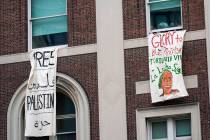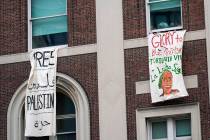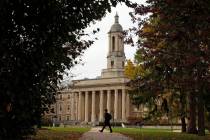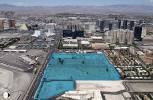Save Frazier’s name, not Frazier Hall
I took a stroll through UNLV's Maude Frazier Hall last week. Not much to look at. The building was about as nondescript as the last time I walked through there in 1984 when registering for freshman classes.
Local preservationists are upset about the university's plan to demolish Frazier Hall. It's 50 years old and was the first building on the UNLV campus, so the presumption is that it has historic value and should be saved from the wrecking ball.
I'm not convinced.
Architecturally, the building is not impressive. Clearly, its design and construction were done on the cheap. UNLV was merely a small branch of the University of Nevada in Reno at that time, and it was a struggle just to persuade state leaders that a building was needed at all. It's not surprising that nobody wanted to spring for a structure with any hint of extravagance.
Structurally, the building is strange -- wide and shallow, with one long hallway. In 1957 it was the university. But it's ill-suited to today's needs at UNLV. What's more, it's in need of major renovations.
And this odd, uninteresting structure sits on prime frontage, where Harmon Avenue intersects with Maryland Parkway.
You wouldn't know it from driving along Maryland, but if you venture by foot onto the UNLV campus, you'll discover a very attractive environment. If the space now occupied by Frazier Hall were employed to create an inviting entryway to the campus, it could be a significant aesthetic improvement for a university still trying to shed its old reputation as "Tumbleweed Tech."
And not coincidentally, a new entrance would dovetail with plans to transform that stretch of Maryland into "Midtown UNLV," a cohesive mix of commercial and residential developments that would enhance the college experience along the lines of what has been done at other universities.
On the Las Vegas Strip, it's pretty well understood that trying to preserve historic buildings is a waste of time and effort. The Strip is an ever-evolving beast dedicated to sweeping away the past and making the most of the present and the future. If you want Strip history, buy a book or watch "Ocean's Eleven."
But this mind-set need not apply to the rest of the Las Vegas Valley, which benefits from any pertinent history it can save. History helps build a sense of identity, and identity helps create a sense of community. Or something like that. It's all very nebulous, but we know that beautiful old buildings where interesting or important things happened stand at the core of the world's great cities.
Frazier Hall, however, doesn't reach this bar. It's not particularly beautiful or interesting. Few faculty or students -- past or present -- have any great affection for the building. It's just in the way.
What preservationists should focus on, I think, is preserving the building's name.
The building is named for a giant figure in the history of Nevada education. Maude Frazier grew up in rural Wisconsin and came to Nevada in 1906. She taught school in Genoa, Beatty, Goldfield and Sparks before going into school administration. In 1921, Frazier was named the state's deputy superintendent of public instruction in Las Vegas. In 1927, she became superintendent of the Las Vegas Union School District, retiring in 1946.
Frazier first suggested the idea of a college in Southern Nevada in 1923, in part because Las Vegas teachers had to attend classes in Reno to maintain their qualifications.
After Frazier won election to the state Assembly in 1950, she worked tirelessly to build support for a college campus here. In 1954, the Board of Regents finally, grudgingly endorsed the idea, but insisted that locals prove their support for the project by raising $100,000 in private funds.
With Frazier leading the charge, local supporters literally went door to door to meet the regents' challenge. That and other fundraising efforts ended up collecting $135,000. For her efforts, Frazier was given the honor of turning the first shovelful of dirt at the new campus. Two years later, the first building was named for her.
Many times, old buildings are worth saving. Morrill Hall, the first building on the University of Nevada, Reno campus, is a good example. Built in 1886, its Victorian architectural style is an elegant southern bookend to UNR's grassy quad.
But in the case of Frazier Hall, the building is not what's important. What's important is that Frazier's name remain prominently displayed at UNLV.
What might be done? Options abound, from naming another building for her to erecting a statue or monument of some kind.
Whatever it is, it ought to be meaningful and hard to miss. The current building is simply not worthy of Maude Frazier's historic importance in the founding of UNLV.
Geoff Schumacher (gschumacher@reviewjournal.com) is Stephens Media's director of community publications. He is the author of "Sun, Sin & Suburbia: An Essential History of Modern Las Vegas" and, coming in February, "Howard Hughes: Power, Paranoia & Palace Intrigue." His column appears Sunday.
GEOFF SCHUMACHERMORE COLUMNS























